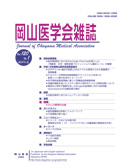

Journal of Okayama Medical Association
Published by Okayama Medical Association<Availability>
Full-text articles are available 3 years after publication.
Permalink : http://escholarship.lib.okayama-u.ac.jp/40795
正常ラット肝由来上皮様細胞の起源
松浦 一彦
岡山大学医学部癌源研究施設病理部
発行日
1989-12
抄録
To investigate the origin of liver epithelial-like cells derived from the normal rat, we examined ten liver epithelial-like cell clones. These cultured cells were isolated from clonogenically growing cells in the primary culture. Morphological, cytochemical and biochemical characteristics of these ten of clones showed the followings: (1) These cells consisted of dense, diffuse and intermediate types. (2) Analyses of serum-free conditioned culture media, using SDS-PAGE, demonstrated that the dense type had a certain profile in the group of secretory proteins, whereas the diffuse and intermediate types had varied profiles although the latter were somewhat similar in profile to the dense type. (3) The secretory protein groups were different from mesenchymal cell lines in their profiles. (4) Cytokeratin was present in all the ten of clones. (5) Cytokeratin was also present in the cholangiolar epithelia and cells localized in peripheral areas of normal hepatic lobules. (6) The function, as seen in mature-type hepatocytes and cholangiolar epithelia, was almost absent. (7) These ten clones were different from sinusoidal endothelia according to their morphologies and growth ability in the primary culture. In conclusion, the liver epithelial-like cell clones derived from normal rat can belong to a “stem-cell family” of liver tissue. These “stem cells” may be localized next to the hepatocytes and cholangiolar epithelia in vivo.
キーワード
ラット
肝細胞培養
上皮様細胞
cytokeratin
stem cell
ISSN
0030-1558
NCID
AN00032489
